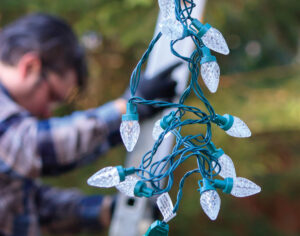Orange road signs are not just for highway construction zones; they also apply to utility work zones. The 2025 National Work Zone Awareness Week is April 21-25. While you should always be a safe driver, remember to take extra caution in a work zone.
According to the U.S. Department of Transportation’s Federal Highway Administration, nearly 900 people died in 2022 in a work zone crash. Speed was the most significant factor in 34% of those deaths. Slowing down before entering work zones helps save lives, including the lives of our crew members, who must often work roadside to maintain or restore power.
Cars or trucks that go too fast do not only endanger workers on the ground. Driving too fast or not moving over can also put a lineworker who is working high up in a bucket in serious danger by causing it to move or sway into high-voltage lines.
Electric utility vehicles and workers often share streets and roadways with motorists in order to access overhead power lines and other electrical equipment. This can be dangerous for workers and motorists.
Safe Electricity urges you to go slowly and be especially careful when you see crews at work. Fatal work zone crashes occur most often in the summer and fall. More than twice as many work zone crashes happen on weekdays compared to weekends, so be extra cautious driving to and from work. To help prevent fatalities and injuries, remember the following guidelines while driving.
- Stay alert. Always be cautious when approaching a work zone. Slow down and pay attention to signs, flaggers and workers. Be prepared for sudden stops.
- Keep a safe distance between your vehicle and traffic barriers, trucks, construction equipment and workers.
Be patient. Traffic delays are sometimes unavoidable, so try to allow time for unexpected delays in your schedule. - Obey all signs and road crew flag instructions. Work zones have reduced speed limits for a reason. Follow them to keep everyone safe. Respect the guidance of barriers, cones and flaggers.
- Merge early and be courteous to other drivers. Don’t wait until the last moment to move over when lanes ahead are closed.
- Use your headlights at dusk and during inclement weather.
Minimize distractions. Avoid changing the radio station, using a cell phone, eating while driving and other distractions.
The most common crash in a roadway work zone is the rear-end collision, so remember to leave at least four car lengths of braking distance between you and the car in front of you. Please, take extra care in work zones, and remember, work zones are temporary — death is final. For more information about electrical safety, visit SafeElectricity.org.









